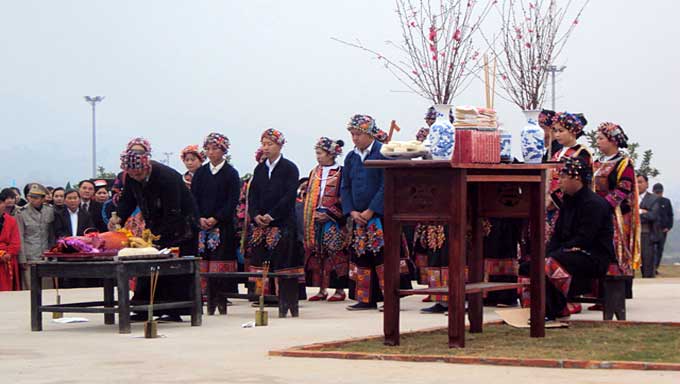The Lo Lo celebrate many rituals each year - the spring ritual, the corn picking ritual, and the rain praying ritual. The Lo Lo in Meo Vac district, Ha Giang province, have held a rain praying festival for generations.

This event is also a venue for people to meet and discuss business and for young people to date.
The Lo Lo pray to their genies for favorable weather, bountiful crops, and a long life. The rain praying festival is observed in the 3rd lunar month in the field.
Lo Sy Pao, head of Sung Pa A hamlet, Meo Vac town, said, “When there is no rain in the 3rd lunar month, we organize a rain praying ritual on the 13th day of the month. When it’s raining, we can begin growing. All villagers contribute offerings.”
They prepare 1 rooster, 2 dogs, 1 wooden or iron sword, wine, a bamboo tube to hold incense, and votive paper. They play bronze drums and a two-string fiddle during the ritual. There are male and female drums representing heaven and earth, the father and mother of the universe.
The two-string fiddle of the Lo Lo is three times bigger than that of other ethnic groups. A rain praying ritual takes two hours.
When the offerings are arranged at the worship place, the sorcerer invites genies to come to the ceremony and bless the people with favorable weather and bumper crop.
Lo Sy Pao noted, “The rain praying ritual is held in the field and all the villagers have to attend. They wear their traditional costumes. We pray to the genies and the father and mother of the universe who gave birth to human beings. If we don’t pray, it will not rain.”
The sorcerer invites the 4 genies guarding the 4 corners of the universe to attend a feast with the villagers.
The rain praying ritual is a religious event of the Lo Lo as well as other ethnic groups in Ha Giang, including the Mong, Tay, and Giay. They talk about their family, marriage, production, and cultivation.
Can Thi Quy in Sung Pa A hamlet shared, “Every household contributes something to the rain praying ritual. People of other ethnic groups living in the area also take part. The festival is a chance for young people to learn about their history and culture. At the festival, we sing and perform our traditional dances.”
After the worship ceremony, the villagers drink a toast, eat, dance, and sing folk tunes in praise of nature and their group’s history.